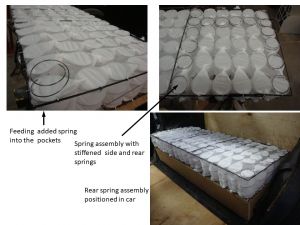- Home
- About Us
- Join/Renew
- Member Benefits
- Member Pages
- Log In
- Help
- Museum Store
I needed to replace all the bottom seat spring units on my ’35 sedan. David Coco’s article in the Model 1 Series 18 Arrow about needing to keep track of the individual springs in the Marshall spring units because they aren’t all the same was quite enlightening, but gave me a headache. All I had left were rusty unusable spring units, so it wasn’t a matter of keeping track of individual springs when replacing the socks and re-assembling, I had to find replacements for all the coils, which vary in height from 8†to 5†front to back. I started looking for seat cushions from parts cars (A bit depressing to try and get parts off of cars being parted out that are better than the car one is restoring). I did that years ago on my Packard but the rear springs were not stiff enough to keep my overweight touché from bottoming out. I don’t know if that was from the springs weakening with age or I was just plain too heavy for them, but decided even if I found used spring units they would still likely only be usable for patterns, and a search for individual spring coils showed I wasn’t going to find the many different combinations of coil height, diameter, wire gauge and stiffness put into a single Pierce Marshall spring unit.
Looking at David’s matrix for a rear seat backrest, it appears there were about 12 different coil designs in a single spring set, when accounting for the different lengths and wire diameters. This would probably translate into 12 separate setup charges to get custom coils wound – not in my budget! Restoration Supply has individual off-the-shelf seat coils available in different heights from 3 ½ to 6â€at $6.00 each, but they are non-constant diameter unsuitable for “marshalizing†with socks.
I finally found some pre-assembled Marshall spring units that came in 18†x 18†packs of 36 springs each that came in 3 firmness levels and 5†and 3†depth. The 5†depth is usable if a constant 5†spring cushion is made instead of the 8†front tapering to 5†in the back. To get the ~9 degree tilt of the seat originally created by the progression of 8†to 5†spring coil height meant making a new tilted spring base. The firmest of the 5†spring units was actually a fairly close match to the original drivers side cushion (it was still intact enough to sit on). But bouncing around on the new unit made the light bulb go off as to a reason besides tapered height for all the variations in the Pierce coil matrix. A constant firmness spring set gives no lumbar support and gives the impression of bouncing around on an inflated ball. The Pierce units doubled up the spring coils on the edges to increase stiffness and provide a bit of a pocket for the touché to sit in, reducing the tendency to slide around with the movement of the car.
To provide some of this characteristic I wound additional spring coils into the edge springs. It isn’t of course an exact match to the original Pierce unit, but as close as I think I can come for a practical solution that doesn’t require selling the house..and it added a bit more support so my delicate touché doesn’t “bottom†out.
Jim

Jim,
Great information and pictures. I have toyed with the idea of redoing the springs in my Series 81. Looks like a big chore! You are on the winning side! Looks great!
Don Benham
Thank you for sharing your very thorough research.
Jim, this is really excellent and valuable information. Thank you! Can you share the source of these spring sets?
But it brought to mind Bill Crumrine’s comment about the individual front seats as used in Broughams and production Silver Arrow coupes: “Like trying to drive while seated on a beach ball!”””
I applaud your ingenuity, and doubly applaud not falling prey to the foam monster! As mentioned, original springs are quite specifically engineered, and I’m sure that over the years numerous cars have springs that weren’t fixed nor put together correctly when repaired.
Well done, a good solution to a difficult problem. By the way, Marshall springs have quite a history and go back quite a ways.
David, thanks for your comments, and thanks of course for your great help on my seat structure, springs as well as the article on the original springs. It never would have occurred to me that there were different coil characteristics to worry about without it!
Jim
I’ve also given permission to reprint the article in a future issue of the AACA magazine, so at some point it may appear there. It was specific to a Pierce Arrow, but applies to a lot of the high end cars.
Glad it was of some help! dc
I was not able to find a source for seat springs and needed to replace some that were damage from exposure to rodent droppings, so I made them using music wire available from McMaster-Carr.
Anyone with access to a lathe can do so too. I made a coil winding mandrel and a brass toolpost clamp. A little experimenting with mandrel diameters and feed rate (inches per turn) yielded perfect repros of the OEM springs.
Go for it!
Bob, sounds like a neat solution to do it yourself, did you take any photos of the setup?
James,
Yes, but I lost them in a computer crash. I may still have the tooling.
